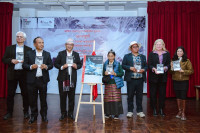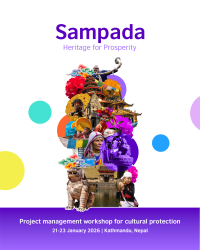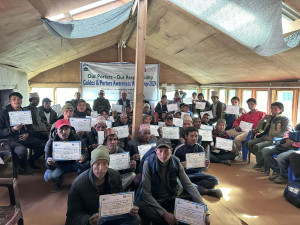Culture & Lifestyle
Preserving tradition amid environmental change
Rooted in rivers and ponds, Chhath in Madhesh now faces the challenges of pollution, shrinking wetlands, and vanishing communal spaces.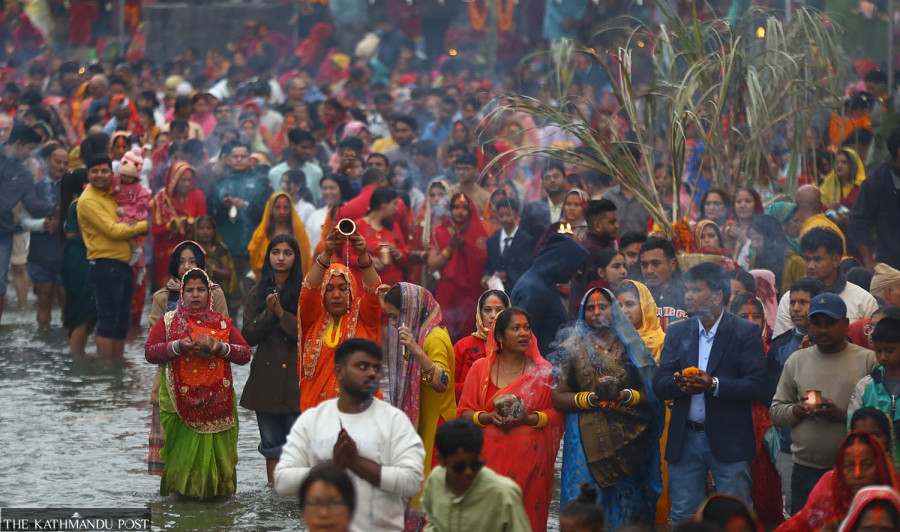
Reeva Khanal
As the sun sets over the plains of Madhesh, women in brightly coloured sarees gather at riverbanks, carrying offerings on brass plates to celebrate Chhath. The festival traces its origins to Sita, the princess of Mithila, who, according to the Ramayan, first offered thanks to the Sun God (Surya) for life and prosperity.
Chhath, dedicated to the Sun God, honours the life-giving forces of water and brings communities together in shared devotion. More than a religious ritual, it reflects the connection between local communities and nature. For generations, women have maintained the festival’s traditions, passing down songs, rituals, and stories that tie families and communities to their rivers, ponds, and the wider environment.
Over time, Chhath has evolved, like many other Hindu festivals, adapting to modern lifestyles and shifting community practices. Yet its connection to rivers, ponds, and wetlands is under threat. Pollution, encroachment, and shrinking water bodies are affecting rituals and the preparation of sacred ghats. This environmental degradation endangers not only the sites but also the centuries-old bond between communities and the ecosystems they have long honoured.
Prince Shah Chaudhary, CEO of Speak Up Nepal, reflects on the decline of traditional Chhath spaces. “My grandmother performed the rituals, and Chhath was a major family gathering, with relatives coming together in laughter and devotion,” he shares.
One of his strongest memories is visiting the local pond before the main day of puja. “We didn’t just show up on the day—we cleaned the entire area, decorated the ghat, and prepared the banks with banana leaves, earthen lamps, sugarcane poles, and colourful cloth. It was a communal effort that turned the space into something sacred,” he notes.
Chaudhary observes that over time, pond banks have been cemented and decorations are often pre-made, reducing the communal preparation that once marked the festival. He notes that the ponds are shrinking, water levels have fallen, and cleanliness has become a growing concern. Many families now create temporary ponds at home, opting for cleaner, private spaces rather than public ones. This shift reflects both environmental neglect and a gradual fading of the community spirit that used to define Chhath celebrations.
Ajay Kumar Yadav, a social entrepreneur from Dhanusha sees Chhath as a strategic reminder of the need to protect the environment. He emphasises that the festival’s connection to water bodies makes it a crucial point of reflection for communities in the Tarai region, where pollution and poor waste management are escalating concerns. “The ponds and rivers that are central to Chhath are being degraded every year,” he explains. “There’s no proper waste management—most of the garbage ends up in these water bodies, worsening their condition.”
Yadav notes that many people in the Tarai have not yet recognised waste management as a pressing issue. “During Chhath, people clean the ponds and ghats for the rituals, but once the festival ends, the neglect returns,” he says.
He further highlights the lack of community ownership over local natural resources. “People often assume that rivers and ponds belong to the government, so they don’t feel responsible for maintaining them,” he observes. “Everything has become politicised—local representatives rarely prioritise these issues, and community resources are being treated as political ones.”
Diwakar Uprety, a young activist working on ecological democracy says that irregular rainfall, rising temperatures, and climate change are causing ponds and wetlands in the Madhesh region to shrink and lose their natural ecosystems. Once clean and ecologically rich, many water bodies are neglected, polluted with human waste, and overrun by concrete blocks.
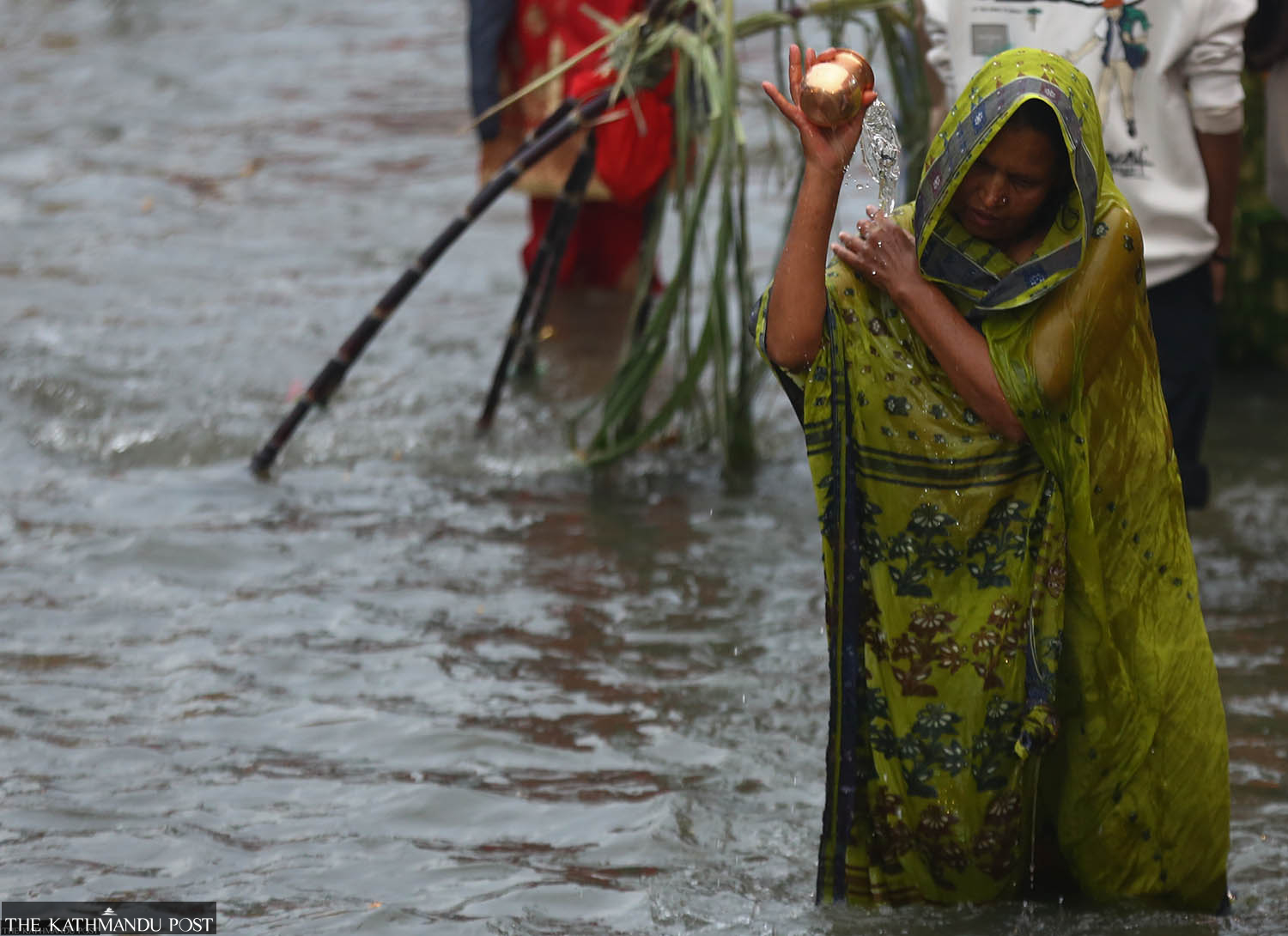
He points out that while devotees continue to perform rituals with faith and devotion, they are often forced to use contaminated ponds surrounded by garbage and single-use plastics. Many sacred ponds remain ignored most of the year, receiving attention only during the festival when locals temporarily clean and decorate them. Some ponds, such as Bishara Pond in Janakpurdham, face severe pollution and even illegal occupation by commercial interests.
Despite these challenges, Uprety notes that community-driven initiatives are making a difference. Youth groups, local committees, and volunteers organise pre-Chhath cleaning campaigns and raise awareness about reducing pollution. Some local governments support these efforts by fencing and beautifying ponds to prevent encroachment. He emphasises that sustained involvement throughout the year, not just during festivals, is essential to preserve these wetlands.
He emphasises the role of local governments and communities in safeguarding Chhath’s traditional spaces. “Local governments and municipalities must take stronger roles in protecting and reviving ponds through sustainable methods, registering and maintaining each pond, preventing illegal occupation, and conducting proper Environmental Impact Assessments (EIAs) before any cemented or decorative work,” he shares. He also stresses the importance of eco-friendly practices during the festival. “During Chhath, using leaf plates or clay items instead of single-use plastics, and encouraging vendors to provide biodegradable options, can make a significant difference,” he adds.
From a sociological and community development perspective, sustainable development practitioner and educator Ashish Sinha explains how environmental degradation directly affects the cultural and spiritual essence of festivals like Chhath.
“Spiritual experiences and celebrations have long revolved around nature,” he notes. “In Madhesh—especially those relying on water and farming—have maintained a delicate balance between natural, socio-cultural, and economic aspects. Life once revolved around celebrations, seasonal changes, and the responsible use of natural resources.”
However, with rapid urbanisation, weak environmental governance, and wetland encroachment, Sinha warns that festivals such as Chhath risk losing their original meaning. “The spiritual essence of Chhath can easily turn into a ritualistic ‘need to do’ when devotees are left with no choice but to use polluted rivers and ghats,” he explains. “Over time, this may discourage participation, especially among women who play central roles in managing the pujas. Health fears—like infections from contaminated water—can also affect the experiential side of the festival.”
For Sinha, community participation and youth leadership are key to long-term preservation. “Young people and cultural gatekeepers are vital to sustaining traditions amidst rapid environmental change,” he asserts.




 7.12°C Kathmandu
7.12°C Kathmandu

